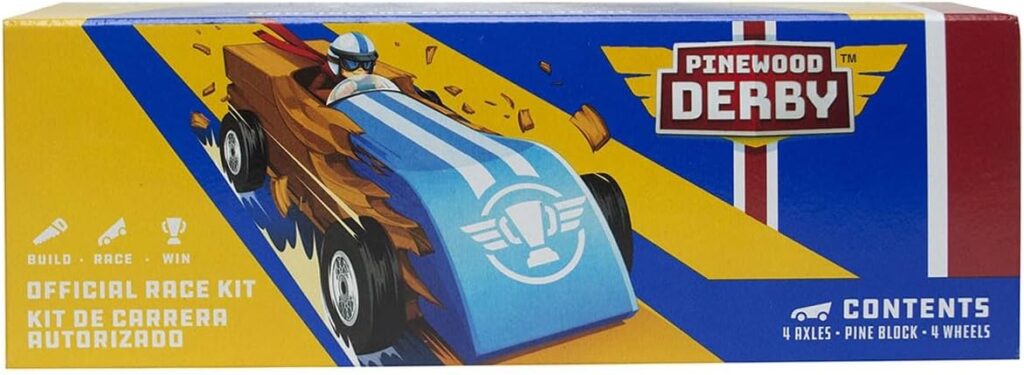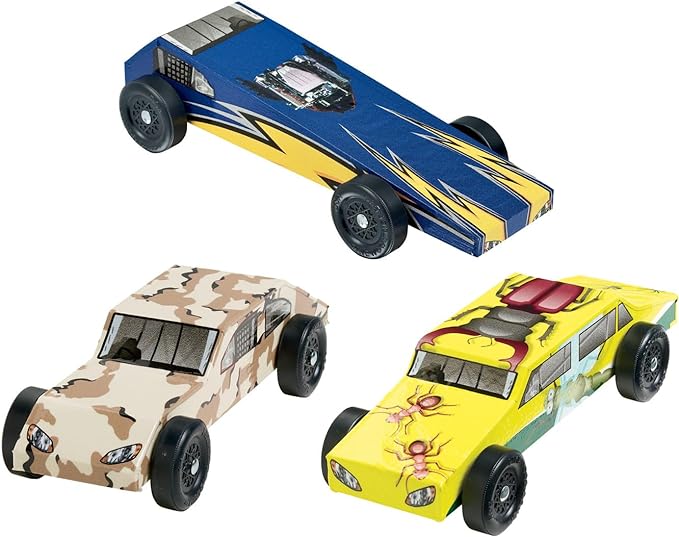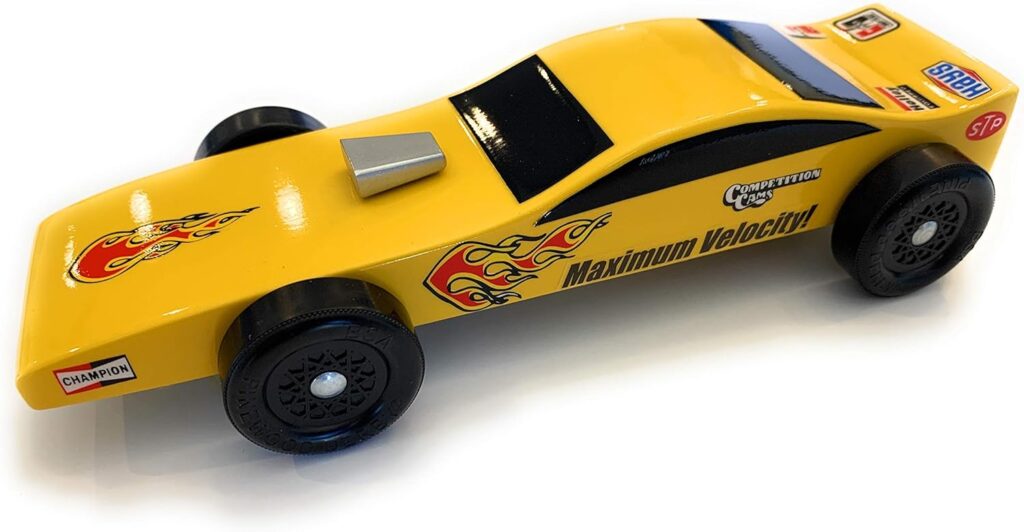The Pinewood Derby is an iconic annual event looked forward to by Cub Scouts across America. Kids get to design and build their own model cars from wood kits and race them in heats down a metal track. It’s a fun STEM activity that involves craftsmanship, creativity, and friendly competition. This guide will walk through everything you need to know about Pinewood Derby cars from kits and tools to shaping methods and racing rules. By the end, you’ll be ready to help your Cub Scout create a speedy, eye-catching car.
What is a Pinewood Derby?
The Pinewood Derby is an annual racing event held by Cub Scout packs across the United States. It involves making model cars from wood kits and racing them down incline tracks. The Pinewood Derby dates back to 1953 when it was created by Don Murphy, a Cubmaster in Manhattan Beach, California. The idea came to him as a way to teach scouts principles of craftsmanship and friendly competition.
Each Pinewood Derby kit contains a block of pine wood, plastic wheels, and metal axles. Cub Scouts, with help from their parents or adult leaders, use these parts to create their own unique cars. The block of wood is carved and shaped into the design of their choice. Wheels are attached with the axles and the car is decorated with paint, stickers, or other embellishments.
On race day, the Cub Scouts line up to compete against each other in heats. The track has a sloped starting ramp that leads to parallel lanes where the cars coast down by gravity. Winners are determined by which car travels the farthest in each heat. There are often multiple divisions so Scouts of different ages can compete fairly. The Pinewood Derby combines STEM skills with creative expression and friendly competition. For many Scouts, it’s the highlight of the year!
What Do You Get in a Pinewood Derby Car Kit?
A Pinewood Derby car kit contains all the basic parts needed to build a car. Kits can be purchased from Scout shops or online retailers. Inside the kit, you’ll find a block of pine wood, plastic wheels, and metal axles.
The wood block is the main component that gets carved into the body of the car. The blocks are standardized at 7 inches long, 1.75 inches wide, and 1.25 inches tall. They are made from pine which is relatively soft and easy to cut and shape. The grain of the wood runs the length of the block so it’s best to shape the car with this in mind.
Also included are four plastic wheels and two nail axles. The wheels have a beveled tread and measure about 1.16 inches in diameter. They are typically colored red, yellow, green and blue. The axles fit into pre-drilled grooves in the wood block. They have a nail head on one end and get trimmed to length once inserted into the wheels.
Additional items like paint, decals, lubricant and sandpaper need to be purchased separately. Weights can also be added to make the car meet the 5 ounce limit. While the kit contains the basic parts, a lot of creativity and problem solving goes into taking a simple block of pine and turning it into a racing machine!
Maximum Velocity Pinewood Car Kit
Boy Scouts of America Official Pinewood Derby Car Kit

What Tools Will I Need to Build My Car?
Building a competitive Pinewood Derby car requires some basic tools for cutting, shaping, and assembling. Many of these common household tools can be found in any garage or workshop.
First, you’ll need saws for trimming and cutting into the wood block. A coping saw works well for making curved cuts and a miter box helps guide straight cuts. Files and rasps further smooth and shape the wood once it’s cut. Sandpaper in coarse and fine grits helps refine the shape even more.
Drills and bits are needed to make the axle holes in the wood block. A drill press is ideal but a handheld drill works too. The axle slots need to be straight and at a 90 degree angle to the track surface. Clamps can hold the block steady while drilling.
An acrylic paint set or spray paints allow you to color and decorate the finished car. Paint brushes, markers, decals and glue provide other embellishment options. A scale ensures the final car is within the 5 ounce weight limit.
Having this array of basic woodworking and crafting tools on hand gives you the means to transform a block of pine into a unique race-ready Pinewood Derby car. While kids will need adult supervision for tool usage, the process allows them to practice hands-on building skills.
How Do I Design and Shape My Car?
Designing and shaping your Pinewood Derby car is one of the most creative parts of the process. While kits provide the basic parts, you can let your imagination run wild when it comes to the car’s look and aerodynamics.
Start by sketching out different design ideas. Consider the overall shape and silhouette you want for your car. Sketch side, top and rear views to visualize the complete 3D form. Add details like fins, spoilers, fenders and other embellishments. Look online and in books for inspiration from real cars or fictional vehicles.
Transfer your final design to the wood block using pencil. Outline the major shape and structural details. Use rulers and templates to aid precision. Clamp the wood securely and cut out the basics with a coping saw. Use files and sandpaper to refine the contours and curves.
Test the car’s aerodynamics by shaping the front to taper and point downward. Carve the underside at an angle to minimize surface touching the track. Sand sharp edges and corners for a smooth airflow. Add wings, fins and spoilers for improved downforce and directional stability.
Focus on finding the ideal balance of design aesthetics and racing performance. Sketch, test and refine the shape over multiple iterations. Your car’s unique form will make it stand out as it zooms down the track.
What Are Some Tips for Painting and Decorating My Car?
Painting and decorating your Pinewood Derby car allows you to show off your creativity and make it look sharp for race day. There are many options for customizing the look.
Start with a base coat of paint. Spray paint works best for full coverage without brush strokes. Do multiple light coats allowing drying time between each. Acrylic craft paint can be used for small details with a brush. Choose glossy paint for a slick, aerodynamic finish.
Consider color schemes that complement the car’s design. Solid colors, fades, flames or camo patterns all look cool. Add contrast with a secondary color on details like stripes, flames or numbering. Refer to photos of real cars for inspiration.
Apply decals and stickers after painting to add visual interest. Create your own with custom name plates, racing sponsors or numbers. Headlights and taillights stickers add realism. Carefully position decals using guides and tweezers.
Add extra details with gel pens, markers, glitter, foil and tape. Outline windows, color headlights or doodle creative shapes. Apply a protective clear coat when done decorating to seal everything in.
Take time making your car look its best. Racers and spectators will be checking out the amazing designs. Let the paint and decorations reflect your interests, hobbies and personality for a one-of-a-kind Pinewood Derby car.

How Are Pinewood Derby Cars Raced and Judged?
Pinewood Derby cars are raced down a metal inclined track to determine the winners. The track has multiple parallel lanes with a starting gate that releases the cars all at once. Races occur in heats of two to four cars depending on track size.
Prior to racing, all cars must pass inspection to meet weight, size and clearance rules. Cars cannot exceed 5 ounces or have loose parts. Wheels must clear the track surface by at least 3/8 inch. Each car is weighed on a scale and gauged with templates.
Heats are organized into several rounds or divisions so cars race against others with similar times. The cars are staged at the starting gates, then released to coast down the track by gravity. Winners advance to face competitors in the next round.
A finish line sensor or judge determines the winner of close heats. Times are recorded for each car. The fastest car in the final round wins the championship. There are also awards for design originality, craftsmanship and theme.
The Pinewood Derby combines friendly competition with creative fun. Scouts display good sportsmanship and learn about fair rules. While winning is exciting, participation and effort count most. With practice, scouts can steadily improve their car designs and racing techniques each year.
Conclusion
The Pinewood Derby has given generations of Scouts lasting memories of crafting their own cars. While winning is exciting, the real reward is the sense of accomplishment in creating something with your own hands. Pinewood teaches valuable skills like design thinking, perseverance, and sportsmanship. Use this guide as a resource as you help your Cub Scout progress from a plain block of pine into a fully decorated race car. The tips inside will set you up for success from start to finish line.
Enjoyed this guide of Pinewood Derby Car Kits? Then be sure to check out our other RC Rating guides.
